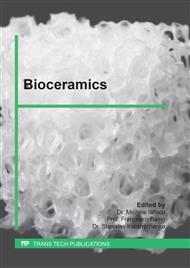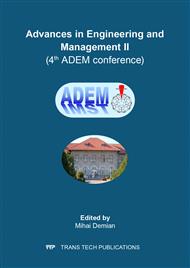[1]
H. Wang, Y. Li, Y.Zuo, J. Li, S. Ma, L. Cheng, Biocompatibility and osteogenesis of biomimetic nano-hydroxyapatite/polyamide composite scaffolds for bone tissue engineering, Biomaterials, 28 (2007) 3338–3348.
DOI: 10.1016/j.biomaterials.2007.04.014
Google Scholar
[2]
A.B.W. Brochu, S.L. Craig, W.M. Reichert, Self-healing biomaterials, J. Biomed. Mater. Res. 96A (2011) 492-506.
DOI: 10.1002/jbm.a.32987
Google Scholar
[3]
C. Schiller, C. Rascge, M. Wehmoller, Biomaterials 25 (2004) 1239-1247.
Google Scholar
[4]
B. Klongnoi, S. Rupprecht, P. Kessler, M. Thorwarth, J. Wiltfang, K.A. Sclegel, Influence of plateletrich plasma on a bioglass and autogenous bone in sinus augmentation (An explorative study), Clin Oral Implants Res. 17 (2006) 312-320.
DOI: 10.1111/j.1600-0501.2005.01215.x
Google Scholar
[5]
C. Von Wilmonsky, E. Vairaktaris, D. Pohle, T. Rechenwald, H. Ltz. R Munstadt, G. Koller, M. Schmidt, Fh. Neukam, K.A. Schlegel, E. Nkenke, Effects of bioactive glass and beta-TCP containing three-dimensional laser sintered polyetheretherketone composites on osteoblasts in vitro, J. Biomed. Mater. Res. 87A (2008).
DOI: 10.1002/jbm.a.31822
Google Scholar
[6]
C. Aparicio, F.J. Gil, C. Fonseca, M. Barbosa, J.A. Planell, Corrosion behavior of commercially pute titanium shot blasted with different materials and sizes of shot particles for dental implant applications, Biomaterials 24 (2003) 263-273.
DOI: 10.1016/s0142-9612(02)00314-9
Google Scholar
[7]
Information on http://phys.org/news/2010-12-medical-implants-high.html.
Google Scholar
[8]
M. Lindner, S. Hoeges, W. Meines, K. Wissenbach, R. Smeets, R. Telle, R. Poprawe, H. Fischer, Manufacturing of individual biodegradable bone substitute implants using selective laser melting technique, J. Biomed Mater. Res. A 97 (2011) 466-471.
DOI: 10.1002/jbm.a.33058
Google Scholar
[9]
J.P. Ping Li, P. Habibovic, M van den Doel, C.E. Wilson, J.R. de Wijn, C.A. van Blitterswijk, K. de Groot, Bone ingrowth in porous titanium implants produced by 3D fiber deposition, Biomaterials 28 (2007) 2810-2820.
DOI: 10.1016/j.biomaterials.2007.02.020
Google Scholar
[10]
D. Espalin, K. Arcaute, D. Rodriguez, F. Medina, M. Posner, R. Wicker, Fused deposition modeling of patient-specific polymethylmethacrylate implants, Rapid prototyping Journal 16 (2010) 164-173.
DOI: 10.1108/13552541011034825
Google Scholar
[11]
A. Royer, J.C. Viguie, M. Heughebaert and J. C. Heughebaert, Stoichiometry of hydroxyapatite: influence on the flexural strength, J. Mater. Sci., 4 (1993) 76-82.
DOI: 10.1007/bf00122982
Google Scholar
[12]
M. Jarcho, C.H. Bolen, M. B. Thomas, J. Bobick, J.F. Kay and R.H. Doremus, Hydroxylapatite synthesis and characterization in dense polycrystalline form, J. Mater. Sci, 11 (1976) 2027-(2035).
DOI: 10.1007/pl00020328
Google Scholar
[13]
X.M. Chen, B. Yang, A new approach for toughening of ceramics, Mater. Lett., 33 (1997) 237-240.
Google Scholar
[14]
I.G. Bucse, C. Ristoscu, B.A. Olei, Structural analysis of PM hydroxyapatite-based composites elaborated by two-step sintering J. Optoelectron. Adv. M., 17 (2015) 1050-1054.
Google Scholar
[15]
D. Veljović, I. Zalite, E. Palcevskis, I. Smiciklas, R. Petrović, D. Janaćković, Microwave sintering of fine grained HAP and HAP/TCP bioceramics, Ceram. Int.,36 (2010) 595-603.
DOI: 10.1016/j.ceramint.2009.09.038
Google Scholar
[16]
M. Eriksson, Y. Liu, J.F. Hu, L. Gao, M. Nigren, Z.J. Shen, Transparent hydroxyapatite ceramics with nanograin structure prepared by high pressure spark plasma sintering at the minimized sintering temperature, J. Eur. Ceram. Soc., 31 (2011).
DOI: 10.1016/j.jeurceramsoc.2011.03.021
Google Scholar
[17]
E. Neovius, T. Engstrand, Craniofacial reconstruction with bone and biomaterials: Review over the last 11 years, J. Plast. Reconstr. Aesthet. Surg. 63 (2009) 1615-1623.
DOI: 10.1016/j.bjps.2009.06.003
Google Scholar
[18]
W.T. Couldwell, C.B. Stillerman, W. Dougherty, Reconstruction of the skull base and cranium adjacent to sinuses with porous polyethylene implant: preliminary report, Skull Base Surg. 7 (1997) 57-63.
DOI: 10.1055/s-2008-1058609
Google Scholar
[19]
C.H. Söderlund, V. Pointillart, M. Pedram, G. Andrault, J.M. Vital, Radiolucent cage for cervical vertebral reconstruction: A prospective study of 17 cases with 2-year minimum follow-up, European Spine Journal 13 (2008) 685-690.
DOI: 10.1007/s00586-004-0747-8
Google Scholar
[20]
R.M. Urban, J.J. Jacobs, M.J. Tomlinson, J. Gavrilovic, J. Black, M. Peocʹh, Dissemination of wear particles to the liver, spleen, and abdominal lymph nodes of patients with hip or knee replacement, J. Bone Jt. Surg. Am. 82 (2000) 457-477.
DOI: 10.2106/00004623-200004000-00002
Google Scholar
[21]
M. Browne, P.J. Gregson, Effect of mechanical surface pretreatment on metal ion release, Biomaterials 21 (2000) 385-392.
DOI: 10.1016/s0142-9612(99)00200-8
Google Scholar
[22]
D. Buser, R.K. Schenk, S. Steinemann, J.P. Fiorellini, C.H. Fox, H. Stich, Influence of surface characteristics on bone integration of titanium implants. A histomorphometric study in miniature pigs. J. Biomed. Mater. Res. 25 (1991) 889-902.
DOI: 10.1002/jbm.820250708
Google Scholar
[23]
F.X. Huber, I. Berger, N. McArthur, C. Huber, H.P. Kock, J. Hillmeier, Evaluation of a novel nanocrystalline hydroxyapatite paste and a solid hidroxyapatite ceramic for the treatment of critical size bone defects (CSD) in rabbits, J. Mater. Sci. Mater. Med. 19 (2008).
DOI: 10.1007/s10856-007-3039-0
Google Scholar
[24]
Y.H. Meng, C.Y. Tang, C.P. Tsui, D.Z. Chen, Fabrication and characterization of needle-like nano-HA and HA/MWNT composites, J. Mater.Sci.Mater.Med 19 (2008) 75-81.
DOI: 10.1007/s10856-007-3107-5
Google Scholar
[25]
Information on http://www.spine.org/Documents/bone_grafts_2006.pdf.
Google Scholar
[26]
Information on www.ceramicindustry.com/articles/93164-93164-advanced-ceramics-market-development.
Google Scholar
[27]
R.A. McIntyre, Common nano-materials and their use in real world applications, Sci. Prog. 95 (2012) 1-22.
Google Scholar
[28]
M. Singh, T. Ohji, R. Ashana, S. Mathur, Ceramic integration across length scales: technical issues, challenges and opportunities in: M. Singh, T. Ohji, R. Asthana, S. Mathur (Eds.), Ceramic Integration and Joining Technologies: From Macro to Nanoscale, A John Wiley and Sons. Inc. Publication 2011, pp.3-14.
DOI: 10.1002/9781118056776.ch1
Google Scholar
[29]
M. Nicoara, C. Locovei, C. Opris, D. Ursu, R. Vasiu, M. Stoica, Optimizing the parameters for in situ fabrication of hybrid Al-Al2O3 composites, J. Therm. Anal. Calorim., Published online: 17 iunie (2016).
DOI: 10.1007/s10973-016-5595-3
Google Scholar
[30]
C. Teisanu, G. Sima, Solid-state foaming in two step sintering to produce HAp-based biocomposites for bone grafting in: A. Rotaru (Ed.), Advanced Engineering Ceramics Materials, Applications and Developments for the Medical, Agrochemical and Abrasive Industries, ACADEMICA Greifswald Publishing House, Germany, ISBN 978-3-940237-38-5, 2016, pp: 35-80.
Google Scholar
[31]
T.M. Keaveny, W.C. Hayes, Mechanical Properties of Cortical and Trabecular Bone in: Bone, Volume 7: Bone Growth-B, Publisher: CRC Press, International Bone and Mineral Society, Elsevier, ISSN 1873-2763, 1993, pp.285-344.
Google Scholar
[32]
W.W. Tomford, Bone allografts: Past, Present and Future, Cell and Tissue Banking, 1 (2000) 105–109.
Google Scholar
[33]
C. Marinescu, A. Sofronia, D. Constantin, S. Tanasescu, Structural, morphological and high temperature characterization of the biocompatible hydroxyaptite-titania composite, J Material Sci Eng, 4 (2015) 143.
Google Scholar
[34]
C. Marinescu, A. Sofronia. E.M. Anghel, R. Baies, D. Constantin, A-M. Seciu, O. Gingu, S. Tanasescu, Microstructure, stability and biocompatibility of hydroxyapatite-titania nanocomposites formed by two-step sintering process, Arabian Journal of Chemistry, available online 9 February (2017).
DOI: 10.1016/j.arabjc.2017.01.019
Google Scholar
[35]
D. Coman, O. Otat, FEM biomechanical analysis of the skull reconstruction using new advanced biocomposite materials, in A. Rotaru (Ed.), Advanced Engineering Materials. Recent Developments for Medical, Technological and Industrial Applications, ACADEMICA Greifswald Publishing House, Germany, 2016, pp.81-113.
Google Scholar
[36]
G. Sima, I. Cinca, C. Teisanu, O. Gingu, Mechanical characterization of the PM hydroxyapatite-based biocomposites elaborated by two-step sintering, Advanced Materials Research, Trans Tech Publications, Switzerland, 1128 (2015) 162-170.
DOI: 10.4028/www.scientific.net/amr.1128.162
Google Scholar
[37]
S. S. Liao, F. Z. Cui, W. Zhang, Q. L. Feng, Hierarchically biomimetic bone scaffold materials: Nano-HA/Collagen/PLA composite, J. Biomed. Mater. Res. B 69 (2004) 158-165.
DOI: 10.1002/jbm.b.20035
Google Scholar
[38]
S. S. Liao, F. Z. Cui, Y. Zhu, Osteoblasts adherence and migration through three-dimensional porous mineralized collagen based composite: nHAC/PLA. J. Bioact. Compat. Polym. 19 (2004) 117-130.
DOI: 10.1177/0883911504042643
Google Scholar
[39]
J. Venkatesan, S-K. Kim, Nano-Hydroxyapatite Composite Biomaterials for Bone Tissue Engineering—A Review, Journal of Biomedical Nanotechnology, 10 (2014) 3124–3140.
DOI: 10.1166/jbn.2014.1893
Google Scholar



